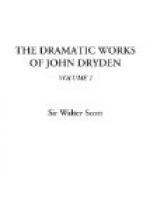The Restoration naturally brought with it a revived taste for those elegant amusements, which, during the usurpation, had been condemned as heathenish, or punished as appertaining especially to the favourers of royalty. To frequent them, therefore, became a badge of loyalty, and a virtual disavowal of those puritanic tenets which all now agreed in condemning. The taste of the restored monarch also was decidedly in favour of the drama. At the foreign courts, which it had been his lot to visit, the theatre was the chief entertainment; and as amusement was always his principal pursuit, it cannot be doubted that he often sought it there. The interest, therefore, which the monarch took in the restoration of the stage, was direct and personal. Had it not been for this circumstance, it seems probable that the general audience, for a time at least, would have demanded a revival of those pieces which had been most successful before the civil wars; and that Shakespeare, Massinger, and Fletcher, would have resumed their acknowledged superiority upon the English stage. But as the theatres were re-established and cherished by the immediate influence of the sovereign, and of the court which returned with him from exile, a taste formed during their residence abroad dictated the nature of entertainments which were to be presented to them. It is worthy of remark, that Charles took the models of the two grand departments of the drama from two different countries.
France afforded the pattern of those tragedies which continued in fashion for twenty years after the Restoration, and which were called Rhyming or Heroic Plays. In that country, however, contrary to the general manners of the people, a sort of stately and precise ceremonial early took possession of the theatre. The French dramatist was under the necessity of considering less the situation of the persons of the drama, than that of the performers who were to represent it before a monarch and his court. It was not, therefore, sufficient for the author to consider how human beings would naturally express themselves in the predicament of the scene; he had the more embarrassing task of so modifying their expressions of passion and feeling, that they might not exceed the decorum necessary in the august presence of the grand monarque. A more effectual mode of freezing the dialogue of the drama could hardly have been devised, than by introducing into the theatre the etiquette of the drawing-room. That etiquette also, during the reign of Louis XIV., was of a kind peculiarly forced and unnatural The romances of Calprenede and Scudery, those ponderous and unmerciful folios now consigned to utter oblivion, were in that reign not only universally read and admired, but supposed to furnish the most perfect models of gallantry and heroism; although, in the words of an elegant female author, these celebrated writings are justly described as containing only “unnatural representations of the passions, false sentiments, false precepts,




